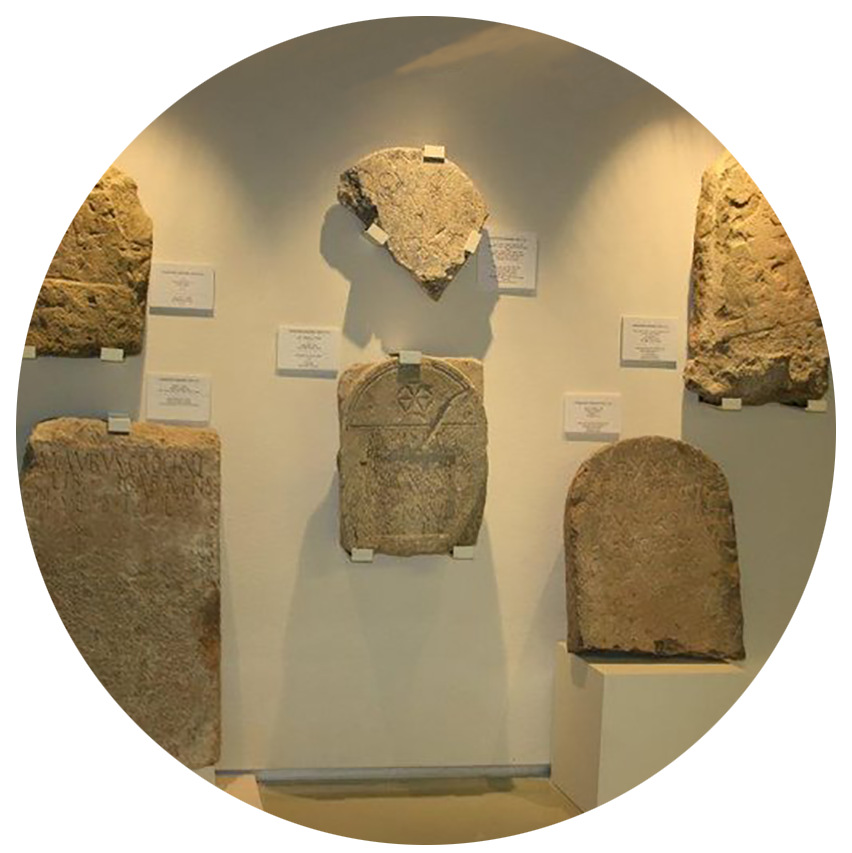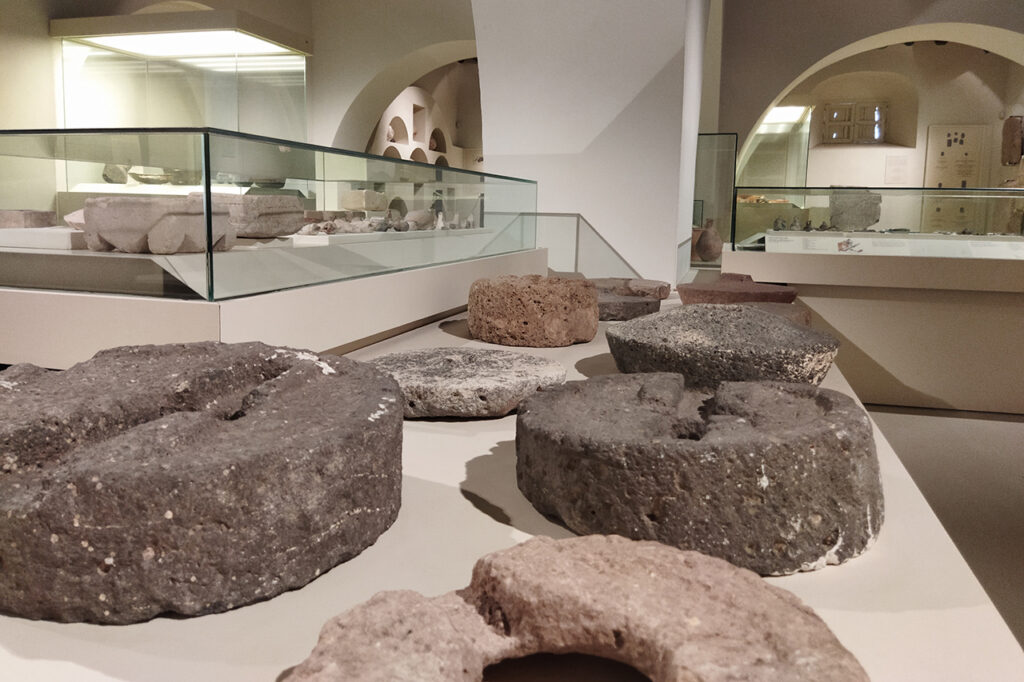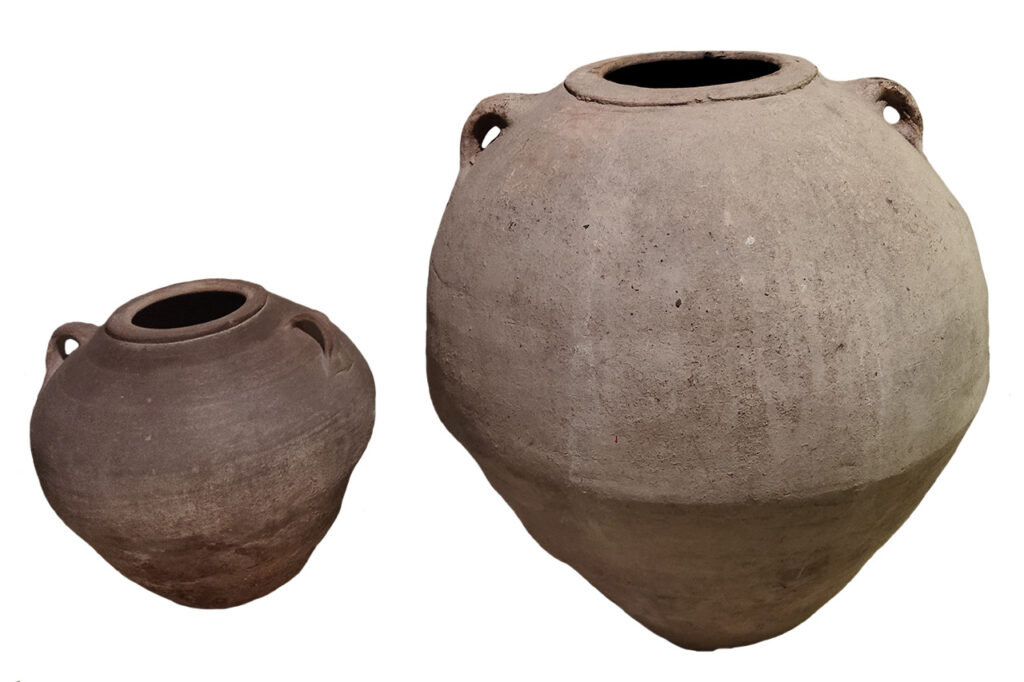
Room V. Roman culture
Roman culture left important testimonies in the archaeological sites of Baena and this is attested in room V of the Museum. In this way, after accessing this space, a large collection of press feet from an de oil mill indicates the importance that olive cultivation had in the region since ancient times, while a display case with numerous plumb lines does the same with respect to to public works and construction in Roman times. Along with these pieces are exhibited mortars , perfume burners and loom weights and other objects of daily life among which a ceramic fragment stands out.sealed with the name of the potter and his name of Iponobensis (a native of the ancient city of Iponuba, a short distance from Baena). Continuing our route to the right, we find a new display case where relatively common metallic pieces are shown, such as anthropomorphic appliqués and and phallic amulets ,but also other rarer ones such as the small ritual jug found in the well of the Oriental Baths of Torreparedones, most probably linked , with the worship of the Goddess of Health. It has the shape of a female head with a delicate hairstyle and a very stylized handle with a perfect adaptation to be able to hold it with the thumb, index and middle fingers of the hand.
Next we find a set of amphoras and examples of dolium that were used to transport food and the appreciated oil that was produced in this area of Baetica . In front of them, a low display case exhibits different Roman tools for farming with an extraordinary resemblance to those used today, despite being between one and the other two thousand years.
Some canvases in which the type of painting that decorated the walls in the houses of ancient Rome is recreated precede some curious pieces of goldsmithing that are in study and the showcase in which various various ceramic pieces , of interest are exhibited, among them a dove (columba) and various representations of the goddess Minerva. Next, a collection of millstones give way to a new showcase in which numerous and varied metal objects from Roman culture are displayed. Amulets , rings , key clips, tweezers, surgical instruments , bells and a small toy brazier that connects us directly with Roman childhood. To his right, the The altar dedicated to the goddess of Health Salvadora, an exceptional piece discovered in the excavations of the Oriental Baths of Torreparedones, while to the left of the display case, we find another with an interesting collection of glass ointments, de vidrio, lucernas skylights and thin-walled ceramics , among other objects. Next, two new exhibitors show us different types of ceramics: the first, the most common, and the second, various terra sigillata models that shaped what has been considered the distinguished tableware of ancient Rome.
We now move on to the space dedicated to the funerary world where, first of all, we will find a wide collection of Roman tombstones , some of them of special interest such as that of Maurus, a freedman igabrensis (a native of Egabrum, the current town of Cabra in Cordoba) or de la Marco Calpurnio and his family, a local hero who must have had a villa with its own necropolis about 2 kilometers from the Torreparedones archaeological park. Next, a recreation of a columbarium shows us different types of ceramic vessels and cinerary urns. in stone, among which are some reproductions of those discovered in 1833 in what is known as the Pompeyos mausoleum, a family tomb that aroused singular interest in the ruins of the ancient city that existed in Torreparedones.
The Roman domus
The domus were the dwellings of families of a certain economic level, whose head of the family ( paterfamilias ) bore the title of dominus . Some of them, such as the “Casa del Panadero” in Torreparedones, were large and usually developed on a single floor. Once through the door of the house, which opened onto a small vestibule,one reached the atrium , a characteristic element of the Roman domus , a covered patio with a central opening (the compluvium )through which rainwater entered. that was collected in a cistern, the impluvium.. From this space, where the lararium or altar was also located where the gods that protected the house were worshiped, access was given to the rest of the rooms in the house, among which was the tablinum or office , the triclinium or room which served as a dining room, the kitchen ( culina ) with its corresponding pantry and the cubicles or bedrooms. Finally, next to the atrium, although in the case at hand with entrance through the vestibule, was the latrine
Some important houses could also have underground cellars and from the II century a. C., following the Greek influence, peristyles ( peristylium) or garden courtyards surrounded by columns began to be built in the rear areas , which gradually gained prominence to the detriment of the atrium whose original function began to decline around the first century AD. C.
Some homes, such as the aforementioned Bakery in Torreparedones, included a space dedicated to an economic activity with the necessary dependencies for it. Also an orchard ( hortus ) and the cistern where the rainwater collected in the impluvium was stored.
A domus in Torreparedones
For a better understanding of day-to-day life in a Roman city, what a domus of the Torreparedones archaeological park would be like has been recreated. It is known as the ” Baker’s House “, one of the examples of domestic architecture of the site.

